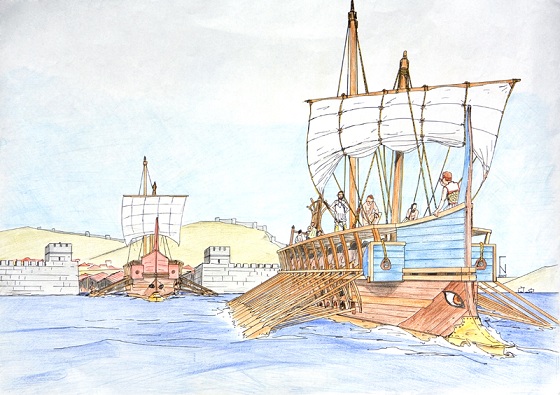The Athenian Trireme (Triere) and the Athenian hegemony
When we think of polyremes, warships with more than a bank of oars, the triere, the most famous of these vessels, comes to our mind. The superiority of this Athenian ship — that was developed in Corinth, with three banks of oars — is confirmed in more than a naval battle, mainly during the Persian Wars. It is however at Salamis that her presence became legendary.
On the night of 17/18 September the fleet of Xerxes, the Great King of the Medes and Persians, Lord of Syria, Chorasmia, India, Egypt, Parthia, Bactria, Lydia, Ionia and many other satrapies, left its Athenian moorings of the Phaleron bay. One thousand triremes, fast oared galleys with more than 200 men crew each, armed with bronze rams capable of smashing through the sides of the enemy ships, pulled round the Piraeus peninsula towards the island of Salamis.
At the same time, in a carefully organized combined operation, a division of the Persian army, 30.000 men strong, lined the northern shores of the bay and ferried a strong detachment of troops on the islet of Psytalia. The task of these soldiers was to finish off the Greek seamen who would struggle ashore from their wrecked ships. There would be no prisoners in this struggle. The Great King was aiming at the final and total destruction of the impertinent Athenians and their allies. In fact not much remained to be done as the Acropolis of Athens itself was covered with smoking ruins. All survivors had fled to Salamis and Troezen on the East coast of the Peloponnesus, Attica was deserted and the only armed force ready to resist the invaders was on board the ships in the harbor of Salamis.
Themistocles the Athenian leader, was the moving spirit of the resistance against the Persians, he realized that fighting of land would be hopeless and that the only chance was to meet Xerxes’ fleet in a decisive battle in the straights of Salamis. He had at his disposal only 180 triremes and was outnumbered 1/5 by the fleet of the Persians, but he counted on the technique of the triremes fighting, which depended entirely on speed and maneuverability. If the heavy Persian ships could be trapped in a limited space, as the straights between the island of Salamis and the mainland, this may then be an ideal opportunity for the Greeks to destroy the invaders’ fleet which lacked maneuverability.
The trireme was circa 37 meters long and had a total crew of 200 men, the 170 were oarsmen – free citizens, not slaves – distributed over three superimposed banks. This ship was designed for one end only: to disable enemy ships. Her weapon was a triple-edged bronze ram; the sleek hull formed a giant spear concentrated on a metal point — fifty tons in weight reaching a speed of 10 knots would tear apart the timber and destroy the planking of any enemy ship it struck. After the blast the importance of the maneuver was for the attaching trireme not to remain entangled with its ram in the enemy ship’s side, but with a full reverse motion of the oarsmen to disentangle, regain its free movement, leaving an enormous hole below the floating line of the attached ship. Besides the perforation on the enemy’s side, the brutal shock of the collision would also disassemble and brake the internal structure of the frames and planking by destroying the intricate mortise-and-tenon assembly of the ship.
An important attempt in experimental archeology consisted in building a full size Athenian trireme. It took 40 years of painstaking research to the leading scholar of ancient oared-ships, John Morrison, who based on literary sources and some scarce iconographic evidence — among which the Lenormant relief – decided to carry out his project. The “Lenormant marble”, a mutilated relief that was found on the Acropolis of Athens in the mid-nineteenth century bears a rare representation of three banks of rowers. Notwithstanding the fact that this is obviously a copy from an original of the Classical times, and that the copyist did not understand well the sequence of the oars it provided sufficient information and in parallel with other fragmentary depictions allowed the construction of a 37 meter long trireme. Building a trireme had been a dream for scholars since the Renaissance and the first who attempted a full scale re-construction of the mythical ship – meant at duplicating the Athenian trireme — was Napoleon III. The ship was built, but when launched, the attempt to row it proved to be a failure.
Named “Olympias” the Athenian trireme, an Anglo-Hellenic project, was successfully launched in 1987 and after numerous sea trials proved to be a most successful project. During the multiple and extended trials, rowed by 170 men (the same number as the ancient ship of the Salamis battle) she performed well and reached speeds of 9 knots per hour.

